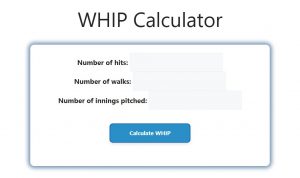About WHIP Calculator (Formula)
In baseball, WHIP (Walks plus Hits per Inning Pitched) is a key statistic used to measure a pitcher’s effectiveness by calculating the number of base runners they allow per inning. Understanding WHIP helps teams and analysts evaluate pitcher performance beyond traditional metrics like ERA.
Formula
To calculate WHIP, use the formula:
WHIP = (Walks + Hits) / Innings Pitched.
How to Use
- Gather Your Data: Obtain the total number of walks, hits, and innings pitched for the pitcher.
- Input the Data: Add the number of walks and hits together.
- Calculate: Divide the sum by the number of innings pitched to find the WHIP value.
Example
Suppose a pitcher has 45 walks, 120 hits, and has pitched 150 innings. Using the formula:
WHIP = (45 + 120) / 150 = 165 / 150 = 1.10
This pitcher’s WHIP is 1.10, indicating they allow 1.10 base runners per inning.

FAQs
- What does WHIP stand for?
WHIP stands for Walks plus Hits per Inning Pitched. - Why is WHIP important?
WHIP provides insight into a pitcher’s ability to prevent base runners, which is crucial for evaluating their overall effectiveness. - How is WHIP different from ERA?
While ERA measures earned runs allowed per nine innings, WHIP focuses on the number of base runners allowed per inning. - What is considered a good WHIP?
A WHIP below 1.20 is generally considered excellent, while above 1.40 may indicate issues. - Can WHIP be negative?
No, WHIP cannot be negative. It is a positive value that reflects the number of base runners allowed. - Does WHIP account for home runs?
No, WHIP only accounts for walks and hits, not home runs. - How often should I calculate WHIP?
WHIP can be calculated after every game or over a season to track a pitcher’s performance trends. - What is the best WHIP in MLB history?
Historical best WHIP values are usually under 1.00, with exceptional pitchers achieving such marks. - Can WHIP be used for comparing pitchers from different eras?
Yes, WHIP is a standardized metric and can be used to compare pitchers across different eras, though league averages may differ. - How do walks affect WHIP?
Walks increase the WHIP value, as they contribute to the total number of base runners allowed. - What role does WHIP play in fantasy baseball?
WHIP is a valuable statistic in fantasy baseball leagues, often used to evaluate and compare pitchers. - Does WHIP consider pitcher’s strikeouts?
No, WHIP does not account for strikeouts; it only considers walks and hits. - How can I improve my WHIP as a pitcher?
To improve WHIP, focus on reducing walks and limiting hits by improving control and pitching strategies. - Is WHIP used in professional baseball scouting?
Yes, WHIP is used by scouts and analysts to assess pitcher performance and potential. - What is the average WHIP for a major league pitcher?
The league average WHIP typically ranges between 1.30 and 1.40. - How do I calculate WHIP for a pitcher who has not completed an inning?
Use the innings pitched fraction (e.g., 0.2 innings) in the calculation to account for partial innings. - Can WHIP be used for relief pitchers?
Yes, WHIP is applicable to both starting and relief pitchers to assess their performance. - How does WHIP affect a pitcher’s win-loss record?
While WHIP itself doesn’t directly affect win-loss records, a lower WHIP generally contributes to better overall pitching performance. - Is WHIP more useful than wins and losses for evaluating pitchers?
Yes, WHIP provides a more nuanced view of a pitcher’s effectiveness compared to wins and losses alone. - Can WHIP help in predicting future performance?
While WHIP provides insights into current performance, it should be combined with other metrics for a fuller picture of future potential.
Conclusion
The WHIP statistic is a crucial tool for evaluating pitchers by measuring the number of base runners they allow per inning. By using our WHIP Calculator, you can easily track and analyze pitcher performance, helping you make informed decisions whether you’re a fan, analyst, or player.
Related:
